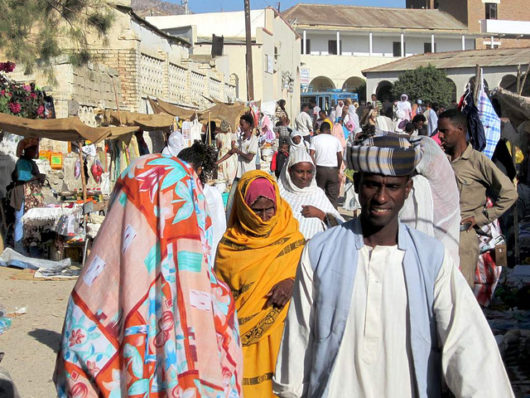Top 10 Facts About Hunger in Eritrea

Eritrea is located at the Horn of Africa in the Sahel Desert that is dominated by arid and semi-arid climatic conditions. The country is, therefore, vulnerable to adverse effects of climate variability, recurring droughts and environmental degradation. The World Bank estimates that 69 percent of Eritrea’s population lives below the poverty line. The economy is largely based on subsistence agriculture, with 80 percent of the population depending on farming and pastoralism.
Eritrea has no free press and political repression of the opposition is rampant. After a severe drought in the Horn of Africa in 2015, president of the country, Isaias Afwerki, polemicized that the country had magically evaded the drought, denying a food crisis. A 2016 U.N. report documents that the president rejected U.N. food aid during the 2015 drought.
The proceeding 10 facts about hunger in Eritrea provide a snapshot of the political climate in the country that ousted humanitarian aid agencies over the last decade, while hunger persisted. The facts also highlight advances in sustainable agriculture and projects that have increased food security.
Top 10 Facts About Hunger in Eritrea
- Since gaining independence in 1993, Eritrea has had tense relations with humanitarian agencies. In July 2005, the country asked the USAID to terminate its operations and leave the country. It continued expelling other international organizations from working within the country in 2006.
- Beginning in 2000, Mercy Corps carried out more than $40 million worth of assistance that alleviated hunger until they closed their operations at the request of the Government of Eritrea in June 2006.
- According to the BBC report in 2011, emaciated Eritreans were crossing the heavily militarised border at the rate of almost 900 people a month, despite official denial of food crisis by President Afwerki.
- In 2013, according to the Food and Agriculture Organization (FAO), over 60 percent of the Eritrean population was reported to be undernourished in the period between 2011 and 2013.
- Eritrea currently meets only a third of its estimated food and the other two-third needs are being met by international food aid programs.
- Data from the Nutrition Sentinel Site Surveillance system indicate an increase in malnutrition rates since 2015 in four out of six regions of the country, and projections estimate that 23,000 children under the age of 5 will need treatment for severe acute malnutrition in 2018.
- In May 2018, the Government of Eritrea donated 40,000 tons of food to South Sudan. The country has already pledged 50,000 tons of food aid for the people of South Sudan in 2017.
- The United Nations Development Programme (UNDP) aimed to increase collaboration with Eritrea to promote sustainability and food security. There has been a success with projects that aim to increase sustainable agriculture in Eritrea, specifically in the small village of Keih-Kor. With the help of the UNDP, the village was able to regain the use of 45 hectares of farmland.
- In the Central Region, UNDP helped build three micro-dams in the Gala-Hefhi sub-region. Over 1,200 villagers benefitted from the dam constructed in Lamza Village, with improved food security and stronger productivity.
- In 2018, UNICEF treated 15,000 children under the age of 5 that had severe acute malnutrition and 40,000 children under the age of 5 with minor acute malnutrition, provided 477,000 children aged 6 to 59 months with vitamin A supplementation and 70,000 children aged 6 to 59 months. Pregnant and lactating women also benefited from supplementary feeding.
Eritrea gained its independence from Ethiopia in 1993. Five years later, the war between the two countries broke out and lasted from May 1998 to June 2000. The conflict saw hundreds of millions of dollars diverted from development aid to arms procurement.
In July 2018, Eritrea signed a historic peace agreement with Ethiopia. Four months following these good measures of social reunification in the Horn of Africa, the United Nations Security Council unanimously lifted international sanctions against Eritrea that have been imposed continuously since 2009. The measures were based on concerns that the Eritrean government was funding and arming the Somali extremist group, Al-Shabaab.
The 10 facts about hunger in Eritrea provide hope that hunger may turn around in the Horn of Africa due to Eritrea’s reconciliation with its neighbors, as the reconciliation could also mean a more open attitude towards humanitarian agencies. There is evidence that suggests that Eritrea could also be a friend in alleviating hunger in the future, across other nations in the Horn of Africa.
– Sasha Kramer
Photo: Flickr
